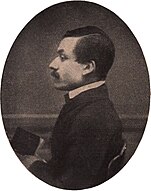
Back Jong Ottomane Afrikaans العثمانيين الشباب Arabic Joves Otomans Catalan Ungtyrkiske parti Danish Jungosmanen German Jóvenes Otomanos Spanish عثمانیهای جوان Persian Jeunes-Ottomans French Նոր օսմաններ (կազմակերպություն) Armenian Giovani ottomani Italian
The Young Ottomans (Ottoman Turkish: یکی عثمانلیلر, romanized: Yeŋî ʿOs̱mânlıler; Turkish: Yeni Osmanlılar[1]) were a secret society established in 1865 by a group of Ottoman intellectuals who were dissatisfied with the Tanzimat reforms in the Ottoman Empire, which they believed did not go far enough.[2] The Young Ottomans sought to transform the Ottoman society by preserving the Empire and modernizing it along the European tradition of adopting a constitutional government.[3] Though the Young Ottomans were frequently in disagreement ideologically, they all agreed that the new constitutional government should continue to be at least somewhat rooted in Islam. To emphasize "the continuing and essential validity of Islam as the basis of Ottoman political culture" they attempted to syncretize an Islamic jurisprudence with liberalism and parliamentary democracy.[4] The Young Ottomans sought for new ways to form a government like the European governments, especially the constitution of the Second French Empire.[5][6] Among the prominent members of this society were writers and publicists such as İbrahim Şinasi, Namık Kemal, Ali Suavi, Ziya Pasha, and Agah Efendi.
In 1876, the Young Ottomans had their defining moment when Sultan Abdul Hamid II reluctantly promulgated the Ottoman constitution of 1876 (Turkish: Kanûn-u Esâsî), the first attempt at a constitution in the Ottoman Empire, ushering in the First Constitutional Era. Although this period was short-lived, with Abdul Hamid II ultimately suspending the constitution and parliament in 1878 in favor of a return to absolute monarchy with himself in power,[7] the influence of the Young Ottomans continued until the collapse of the empire. Several decades later, another group of reform-minded Ottomans, the Young Turks, repeated the Young Ottomans' efforts, leading to the Young Turk Revolution in 1908 and the beginning of the Second Constitutional Era.
- ^ The Turkish name Yeni Osmanlılar literally means "New Ottomans", but the translation "Young Ottomans" is traditional.
- ^ Akgunduz, Ahmet; Ozturk, Said (2011). Ottoman History: Misperceptions and Truths. IUR Press. p. 318. ISBN 978-9090261089.
- ^ Lapidus, Ira Marvin (2002). A History of Islamic Societies. Cambridge University Press. p. 496. ISBN 0521779332.
- ^ Finkel 2006, p. 475.
- ^ Cleveland, William and Bunton, Martin (2009). A History of the Modern Middle East, Fourth Edition, Westview Press. p. 85. ISBN 978-0-8133-4374-7.
- ^ The Genesis of Young Ottoman Thought. Şerif Mardin p.311
- ^ Finkel 2006, p. 489-490.

